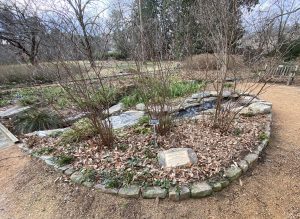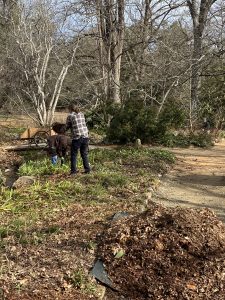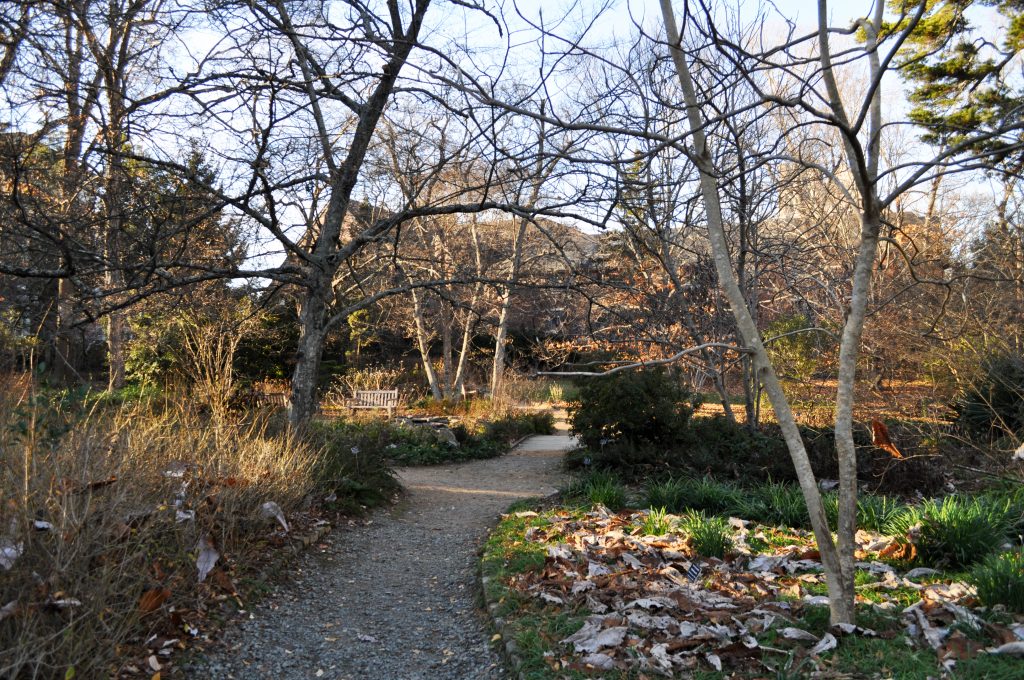Coker Arboretum in Winter
By Margo MacIntyre, Curator, Coker Arboretum

This is one of the most frequent questions we get while working in Coker Arboretum, especially at this time of year when signs of spring are subtle, and the weather is cold. Our work in the winter garden is vigorous, but often requires gentleness and finesse. The truth is, we have plenty to do during all seasons of the year, but winter is when we can really take time to do jobs thoroughly and assess and improve the composition, size, and shape of each garden bed and space around each tree. It’s not a down time at all.
In early winter, gardeners spend time collecting leaves and redistributing them throughout the Arboretum. Whenever possible, leaves remain where they fall to avoid disturbing the life within and under them. The exceptions to this are when they are on lawns or pathways. Our ‘lawns’ are low-maintenance, generally green spaces, and I regard those as areas people expect to remain clean and green all the time. All leaves from the lawns are raked or blown, and ground for mulch to use on around trees and in garden beds. Leaves in natural areas are left exactly where they fall, and these spaces are also good repositories for leaves from walks. This requires almost no moving of leaves, except by raking or blowing.

By January’s end, most of our leaves are either in gardens and ready for spring or are destined for gardens once the February work is complete. February work includes getting gardens ready for spring by cutting most of the perennial stems down, weeding, dividing, and finally, mulching with our own double-ground leaves or UNC’S composted leaves. By this time, we are doing the very tedious and careful task of working and weeding around bulbs and spring ephemerals that are already poking up. All the large areas around trees in the Arboretum receive leaves from the University’s collection operations, so these leaves are already ground, local, and free. There’s an endless supply of these, and their use really ties everything together to make visitors feel welcome in a well-maintained space–and that’s my goal.
If we have learned anything in these past two years, it is that time outside is both healthy and safe. There’s a lot of air out there. Being outside is good for mental and physical health even when the weather is cold and gray in January and February. The winter garden has a lot to offer to those who want to linger and breathe fresh air, and we’d love to see you in the garden often.
Visiting regularly in February gives a window into the magical world of early spring in the Arboretum. The winter garden reveals structure, color, and texture that we can only appreciate without the leaves and flowers. The tree trunks display a spectrum of colors from black and gray to brown and rust, and though they are more subtle, the colors are remarkable. There are also many evergreen plants that are not noticed in the growing season.
Visitors can also always ask questions and meet the Coker Nuts, our volunteers, and our fantastic team of work study students. Even though we are working, we aren’t too busy to answer questions, meet the dog, or to show folks other interesting things we see in our work. Come see us!
The third Saturday tours start again in March, so be on the lookout for those.
